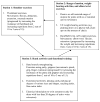A community-based upper-extremity group exercise program improves motor function and performance of functional activities in chronic stroke: a randomized controlled trial
- PMID: 16401430
- PMCID: PMC3123334
- DOI: 10.1016/j.apmr.2005.08.113
A community-based upper-extremity group exercise program improves motor function and performance of functional activities in chronic stroke: a randomized controlled trial
Abstract
Objective: To assess the effects of a community-based exercise program on motor recovery and functional abilities of the paretic upper extremity in persons with chronic stroke.
Design: Randomized controlled trial.
Setting: Rehabilitation research laboratory and a community hall.
Participants: A sample of 63 people (> or =50y) with chronic deficits resulting from stroke (onset > or =1y).
Interventions: The arm group underwent an exercise program designed to improve upper-extremity function (1h/session, 3 sessions/wk for 19wk). The leg group underwent a lower-extremity exercise program.
Main outcome measures: The Wolf Motor Function Test (WMFT), Fugl-Meyer Assessment (FMA), hand-held dynamometry (grip strength), and the Motor Activity Log.
Results: Multivariate analysis showed a significant group by time interaction (Wilks lambda=.726, P=.017), indicating that overall, the arm group had significantly more improvement than the leg group. Post hoc analysis demonstrated that gains in WMFT (functional ability) (P=.001) and FMA (P=.001) scores were significantly higher in the arm group. The amount of improvement was comparable to other novel treatment approaches such as constraint-induced movement therapy or robot-aided exercise training previously reported in chronic stroke. Participants with moderate arm impairment benefited more from the program.
Conclusions: The pilot study showed that a community-based exercise program can improve upper-extremity function in persons with chronic stroke. This outcome justifies a larger clinical trial to further assess efficacy and cost effectiveness.
Figures



References
-
- Nakayama H, Jorgensen HS, Raaschou HO, Olsen TS. Recovery of upper extremity function in stroke patients: The Copenhagen Stroke Study. Arch Phys Med Rehabil. 1994;75:394–98. - PubMed
-
- Parker VM, Wade DT, Hewer RL. Loss of arm function after stroke: measurement, frequency, and recovery. Int Rehabil Med. 1986;8:69–73. - PubMed
-
- Anderson C, Jamrozik K, Stewart-Wynne E. Physical disability after stroke in the Perth Community Stroke Study. Clin Exp Neurol. 1990;27:121–4. - PubMed
-
- Gresham GE, Fitzpatrick TE, Wolf PA, McNamara PM, Kannel WB, Dawber TR. Residual disability in survivors of stroke-the Framingham study. N Engl J Med. 1975;6:954–6. - PubMed
Publication types
MeSH terms
Grants and funding
LinkOut - more resources
Full Text Sources
Other Literature Sources
Medical

